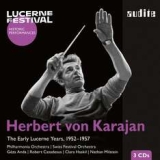Die Achte Symphonie von Ludwig van Beethoven eröffnet die erste CD dieser Kollektion von Livemitschnitten aus Luzern. Aufgenommen wurde sie 1952 mit dem Swiss Festival Orchestra. Es ist die spannendste Aufnahme der Achten mit Karajan, die ich kenne. Der drängend pulsierende erste Satz ist der längste aller Karajan-Einspielungen, aber er ist kontrastreicher, transparenter als die anderen und voller Spannung. Nicht weniger gut gelungen ist das rhythmische Allegretto, während das Menuett schon eher an spätere Interpretationen erinnert und das Allegro vivace sehr tänzerisch und gleichzeitig zupackend gespielt wird, so dass der Satz sehr rhetorisch wird.
Mozarts Klavierkonzert KV 491 mit Robert Casadesus und Karajan zeichnet sich durch eine sehr spontan klingende, kontrastreiche und klangvolle Interpretation aus, die Mozart sehr dramatisch werden lässt.
Am Ende der ersten CD erklingt die einzige Aufnahme dieser Zusammenstellung, die schon vorher bei Audite auf CD veröffentlicht wurde, das Konzert für zwei Klaviere und Orchester BWV 1061 von Johann Sebastian Bach, aufgenommen 1955 unter der Leitung von Herbert von Karajan, mit Clara Haskil und Géza Anda. Die Interpretation ist ein Kind ihrer Zeit und ein Zeugnis der engen Zusammenarbeit Karajans nicht so sehr mit Anda, aber vor allem mit Haskil, die der Dirigent verehrte und mit der er viele Konzerte gab.
Die zweite CD enthält die Symphonien Nr. 6 von Beethoven und Nr. 4 von Brahms mit dem Philharmonia Orchestra London, aufgenommen im Jahre 1956.
Es ist viel darüber diskutiert worden, welcher Beethoven-Zyklus von Karajan der Beste ist. Es gibt viel Gründe, den Londoner Zyklus aus den Fünfzigerjahren zu bevorzugen, auch wenn ich, aufs Ganze gesehen, den aus Berlin von 1977 für den besten halte. Die Liveaufnahme aus Luzern entspricht weitgehend der Londoner Studioaufnahme.
Die Pastorale hat viel Frische und Spontaneität, und der zweite Satz ist in seiner unbekümmerten Art besonders liebenswert. Der Sturm ist hoch dramatisch und der letzte Satz sehr entspannt.
Die Vierte Symphonie von Brahms wechselt zwischen Drama, Melancholie und schwärmerischem Lyrismus.
Die dritte CD beginnt mit dem Brahms-Violinkonzert mit dem Swiss Festival Orchestra und Nathan Milstein. Dieser besticht durch seine mühelose Virtuosität und seinen glänzenden, singenden Ton. Karajan dirigiert aufmerksam und lässt das Orchester leidenschaftlich singen.
Karajan dirigierte Honeggers 3. Symphonien oft im Konzert und auf Schallplatten. Seine Interpretationen gehören zu den Besten dieser Komposition
Karajan wird den Gefühlen des Komponisten voll gerecht, der den « menschlichen Schwachsinn », den die Welt während des Zweiten Weltkriegs erlebt hatte, geißeln wollte.
Dreizehn Jahre nach dem Ende des Zweiten Weltkriegs gestaltete Karajan dieses Bekenntniswerk emphatisch und mit größter Energie. Das ergibt eine Interpretation von größter Wirkung!
Erwähnenswert ist, dass Audite als Bonus die Aufnahme der h-Moll-Messe von Bach mit dem Wiener Symphonikern und dem Wiener Singverein in einer Aufnahme von 1951 zum Download anbietet.
Exzellent ist das reich dokumentierte Textheft der Dreierbox, in dem auch viele bisher unveröffentlichte Fotos von Karajan zu sehen sind.
Ludwig van Beethoven’s Eighth Symphony opens the first CD of this collection of live recordings from Lucerne. It was recorded in 1952 with the Swiss Festival Orchestra. It is the most exciting recording of the Eighth with Karajan that I know. The urgently pulsating first movement is the longest of all Karajan recordings, but it is richer in contrast, more transparent than the others, and full of tension. The rhythmic Allegretto is no less well done, while the Minuet is already more reminiscent of later interpretations, and the Allegro vivace is played very dance-like and at the same time gripping, so that the movement becomes very rhetorical.
Mozart’s Piano Concerto K. 491 with Robert Casadesus and Karajan is distinguished by a very spontaneous-sounding interpretation, rich in contrasts and rich in sound, which allows Mozart to become very dramatic.
The end of the first disc features the only recording of this compilation previously released on CD by Audite, the Concerto for Two Pianos and Orchestra BWV 1061 by Johann Sebastian Bach, recorded in 1955 under the baton of Herbert von Karajan, with Clara Haskil and Géza Anda. The interpretation is a child of its time and a testimony to Karajan’s close collaboration not so much with Anda, but especially with Haskil, whom the conductor adored and with whom he gave many concerts.
The second disc contains Beethoven’s Symphony No. 6 and Brahms’ Symphony No. 4 with the Philharmonia Orchestra London, recorded in 1956.
There has been much debate about which of Karajan’s Beethoven cycles is the best. There is much reason to prefer the London cycle from the 1950s, although, taken as a whole, I think the one from Berlin in 1977 is the best. The live Lucerne recording is much the same as the London studio recording.
The Pastorale has much freshness and spontaneity, and the second movement is particularly endearing in its carefree manner. The Tempest is highly dramatic and the last movement very relaxed.
Brahms’ Fourth Symphony alternates between drama, melancholy and rapturous lyricism.
The third CD begins with the Brahms Violin Concerto with the Swiss Festival Orchestra and Nathan Milstein. The latter captivates with his effortless virtuosity and brilliant, singing tone. Karajan conducts attentively and makes the orchestra sing passionately.
Karajan conducted Honegger’s 3rd symphonies often in concert and on record. His interpretations are among the best of this composition
Karajan does full justice to the feelings of the composer, who wanted to castigate the « human imbecility » that the world had experienced during World War II.
Thirteen years after the end of World War II, Karajan shaped this confessional work emphatically and with the greatest energy. This makes for an interpretation of the greatest impact!
It is worth mentioning that Audite offers as a bonus download the recording of Bach’s Mass in B minor with the Vienna Symphony and the Vienna Singverein in a 1951 recording.
Excellent is the richly documented text booklet of the three-disc box set, which also includes many previously unpublished photos of Karajan.
























